| July
7, 2007
Hello from Toronto: Exploring Riverdale
and Queens Park by Bicycle
There is no doubt in my mind that bicycling is one of the best
ways, if not the best way, to explore a city. You cover more than
walking, you can easily stop anywhere, and you can get to the hidden
spots that you wouldn’t be able to access by car and transit.
I have decided that this summer I am going to spend a lot of time
exploring Toronto, perched on the padded seat of my bicycle.
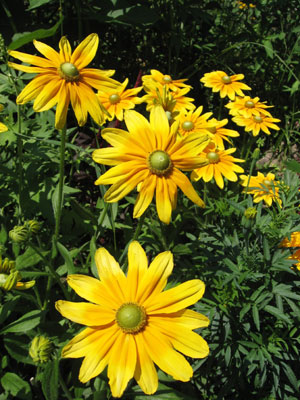
Toronto blooms
So after last week’s official Toronto biking tour with Sights
on Bikes, today I set off by myself to check out the city. On a
beautiful Saturday morning I left Toronto’s east end and cycled
into the Taylor Park Creek system which is a beautiful and serene
valley surrounding a creek, completed devoid of vehicular traffic.
I came back up at Stan Wadlow Park near Woodbine Avenue and cycled
westwards on one of Toronto’s designated bicycle lanes on
Cosburn Avenue, turned south on Logan Avenue and made my first stop
at Withrow Park where several merchants were selling a wide variety
of home grown and organic food products. The action on the playground
was in full swing (literally) and local East York and Riverdale
residents had come out to enjoy and sample the bounty that was on
offer.
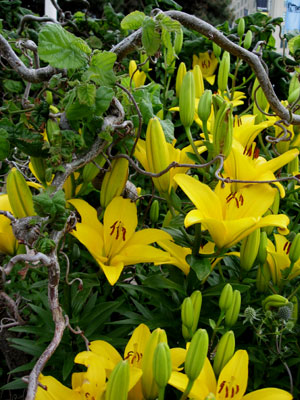
Colour abounds everywhere
Cycling west on Hogarth Avenue I decided to do an experiment: to
cycle while the camera was rolling to give my viewers a real idea
of what this neighbourhood looks like. The Riverdale area, located
south of Danforth Avenue – East Toronto’s main thoroughfare,
is a quaint residential area with Victorian homes and tall, leafy
trees. Over the last few years, many homes in the Riverdale area
have been upgraded and renovated, and the resulting gentrification
and the central location have made it a very popular neighbourhood.
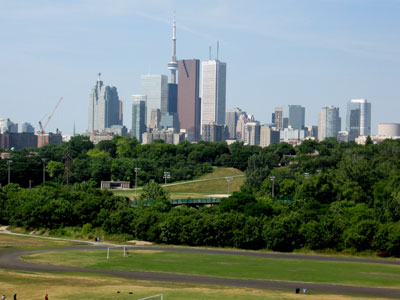
A great downtown vista from Broadview Avenue
I arrived at Broadview Avenue, a north-south connection between
Danforth and Eastern Avenues. Broadview Avenue overlooks the Don
River Valley and offers several excellent lookout points of the
downtown skyline. I stopped to take in the amazing panoramic view
of Toronto’s downtown skyscrapers and watched the hustle and
bustle on the Don Valley Parkway while soccer players were getting
their exercise on the fields below the embankment.
Just minutes south of here I stopped at the intersection of Toronto’s
Eastern Chinatown at Broadway and Gerrard Streets. The City of Toronto
features the second largest Chinese population in Canada after Vancouver
and has three Chinatowns within its city limits. The Chinese and
Vietnamese stores at Broadview and Gerrard stretch from Broadview
to Carlaw Avenue along Gerrard Street and sell inexpensive produce,
meat, seafood and other general merchandise.
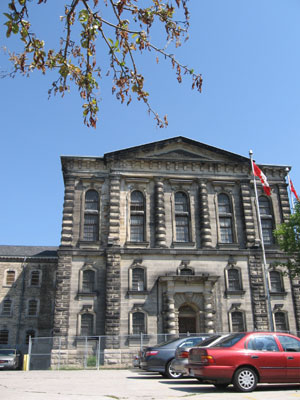
The infamous Don Jail
Close by is a historic landmark: the Don Jail was built between
1862 and 1865 and is one of Victorian Toronto’s most important
remaining intact structures. The jail was expanded in the 1950s
to increase capacity. The facilities in the old section of the prison
are very outdated and one particular judge actually credited a person
with three days for every one day spent serving in the prison, just
to account for the harsh circumstances. The Don Jail was also the
location of Canada’s last hangings: two convicted murders
were hanged here in 1962.
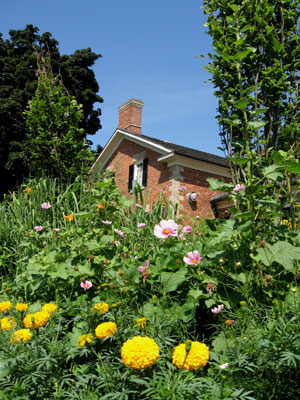
Riverdale Farm
I then crossed the bridge over the Don Valley and cycled north
on Sumach Road to head into the Cabbagetown neighbourhood for a
quick visit to Riverdale Park, a public part that features athletic
fields and is anchored around Riverdale Farm, a publicly accessible
farm that is operated by the city. From 1888 onwards Riverdale Farm
was actually Toronto’s Zoo, but after the opening of the much
larger Toronto Zoo in the eastern end of Scarborough in 1974, this
site was converted into a farm that is accessible free of charge
from April to October.
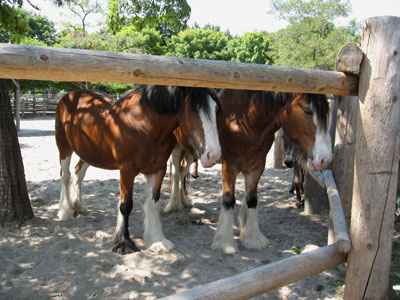
The horses are enchanting the crowd
Riverdale Farm is extremely popular with young families since it
features farm animals such as horses, donkeys, cows, goats, sheep,
pigs and poultry. Groups of young children were gathered around
the horse pen and checked out the various barns with different animals
in it. I had to chuckle when I saw one of the city workers taking
two goats and several kid goats for a walk on a leash – I
had never seen a goat on a leash before. Riverdale Farm features
a central farmhouse, a tearoom that sells snacks and refreshments
as well as washroom facilities. The grounds around the farm house
are beautifully maintained and landscaped with a wide variety of
flowers that are in full bloom.
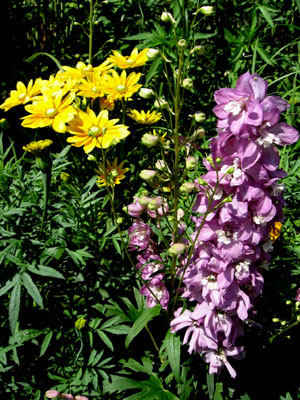
Blooms at Riverdale Farm
The north entrance to Riverdale Farm is exactly opposite another
historic Toronto landmark: the Necropolis Cemetery is the oldest
burial ground in Toronto with many graves dating back to the early
1800s. Many early famous Toronto personalities are buried here,
including George Brown, the founder of the newspaper that became
the Globe and Mail, as well as William Lyon Mackenzie – Toronto’s
first mayor. Beautiful gravestones tell tales of times long-gone,
and of the cemetery’s 50,000 residents, each of whom left
a mark on this city.
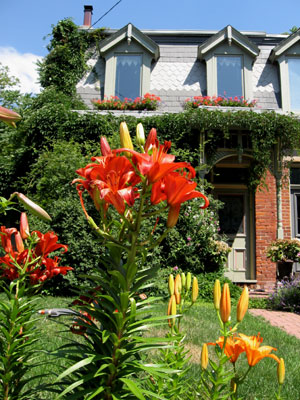
Historic house in Riverdale
The area surrounding Riverdale Farm and the Necropolis Cemetery
is called Cabbagetown, a residential area that got started in the
1840s by Irish immigrants. The name of the neighbourhood originated
because the relative poor residents resorted to growing cabbage
in their front yards. Cabbagetown has undergone substantial gentrification
since the 1970s and today is one of the most desirable and picturesque
residential neighbourhoods in the city. Many successful urban professionals,
professors, artists and politicians call this Heritage Conservation
District their home.
From Cabbagetown I cycled west on Wellesley Avenue, a major east-west
connection in downtown Toronto. I crossed the intersection of Church
and Wellesley, the heart of Toronto’s gay community. The Church
Wellesley Village is one of Canada’s most vibrant communities
and home of various special events such as Pride Week and the Church
Street Fetish Fair. Dozens of shops, restaurants, bars and outdoor
patios make this a popular entertainment district.
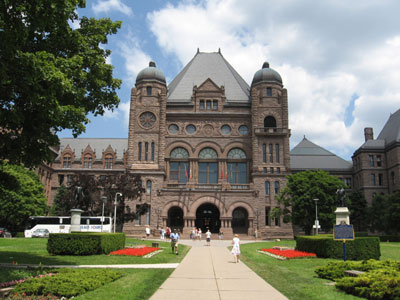
Queen's Park
Continuing past Yonge Street, Toronto’s main north-south
artery that was formerly listed as the longest street in the world
in the Guinness Book of Records, I continued towards Queen’s
Park, site of the Ontario Legislature. The park surrounding the
Legislative Assembly of Ontario was opened by Edward, Prince of
Wales in 1860 and named after Queen Victoria.
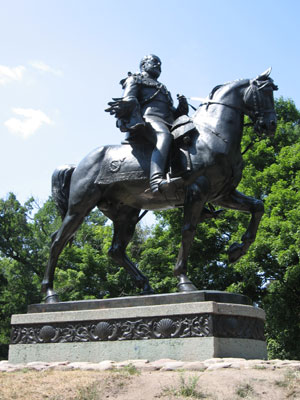
Statue in Queen's Park
One of the architectural crown jewels of Toronto, the Ontario Legislative
Building was designed by Buffalo-based architect Richard A. Waite,
and completed in a Richardsonian Romanesque style in 1893. The northwest
corner also features the apartment of the Lieutenant-Governor of
Ontario, the Queen’s representative in this province, since
1937. Various statues of famous politicians grace the grounds and
the area on the south side of the building facing University Avenue
is often used for ceremonial occasions.
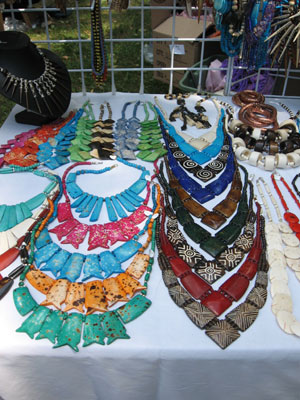
Jewelry on sale at Afrofest
Today, the park area on the north side of the Legislature was full
of merchants, getting ready for Afrofest. Various Caribbean and
African entrepreneurs were getting ready to sell all sorts of food,
clothing, music, jewelry and other ethnic products. I would have
loved to sample some of delicacies, but when I arrived around noon
time the food stands were still getting set up and none of the food
was ready yet.
Heading west from Queens Park I entered the campus of the University
of Toronto, with about 60,000 students Canada’s largest university
which was founded as King’s College in 1827. According to
a 2006 Newsweek International Ranking, U of T is the first-ranked
university in Canada, and comes in as number 18 world-wide and number
5 outside the United States. Researchers at the University of Toronto
have been responsible for such discoveries and achievements as the
extraction of insulin, the first practical electron microscope,
and the world’s first electronic heart pacemaker.
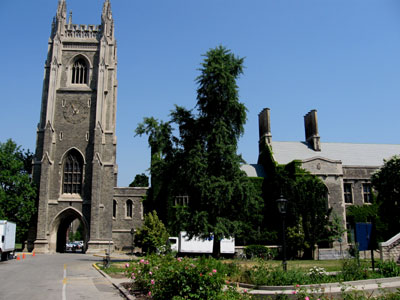
Hart House, part of the University of Toronto
The central part of the downtown campus of U of T features some
stunning architectural heritage buildings in the Romanesque and
Gothic revival style, particularly on King’s College Circle.
Hart House, a multi-purpose student centre was financed by donations
by the Massey Foundation and named after Hart Massey (1823-1896),
the Canadian industrialist who founded a successful farm equipment
empire.
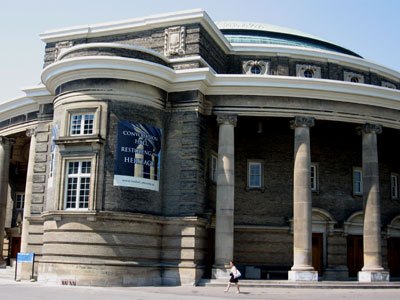
Convocation Hall, part of U of T
By now my appetite had been triggered and I was ready to have a
nice lunch, so I cycled south on McCaul Street to Baldwin Street
which features two blocks of eclectic and diverse eateries, most
of whom have outdoor patios on the street side. Indian, Chinese,
Japanese, French, Italian and Thai restaurants are represented on
this quaint neighbourhood street, offering a wide range of eclectic
tastes. I plunked myself down at the Kuni Sushi Ya Restaurant and
satiated my hunger with a miso soup and a very satisfying vegetable
tempura while contemplating the remainder of my route. The great
thing is that Baldwin Street is a rather relaxed, Bohemian Street,
so even in my biking outfit with messy hair I did not attract any
uncomfortable attention.
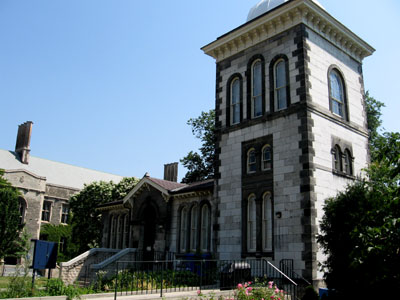
University of Toronto campus
After strengthening myself I continued my ride south on Beverley
towards the Rogers Centre, the former Skydome, Toronto’s multi-purpose
stadium with the unique retractable roof and home to the Toronto
Blue Jays (Major League Baseball) and the Toronto Argonauts (Canadian
Football). I was particularly fascinated by the outdoor sculptures
on the northwest side of the stadium: “The Audience”
portrays a variety of sports fans who are celebrating their favourite
team’s achievements.
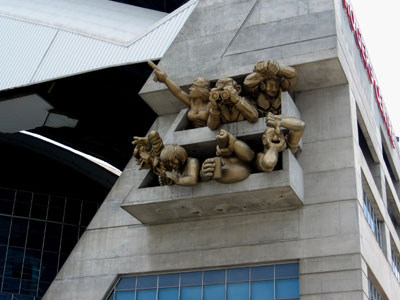
"The Audience", sculpture on the Rogers Centre
A couple of minutes west on Blue Jays Way I stopped at a memorial
to Chinese railway workers, who helped build Canada’s railways
in the second half of the 19th century. Many of these Chinese labourers
made up the main labour force in the construction of the Canadian
Pacific Railway in British Columbia. 5000 railway workers were recruited
from China and an additional 7000 Chinese labourers were brought
in from California. Many of these workers either became ill during
construction or died while planting explosives or perished in various
construction-related accidents. Living conditions were squalid and
the workers generally lived in tents. The monument to the Chinese
railway workers pays a moving tribute to the contribution and fate
of the Chinese railway workers.
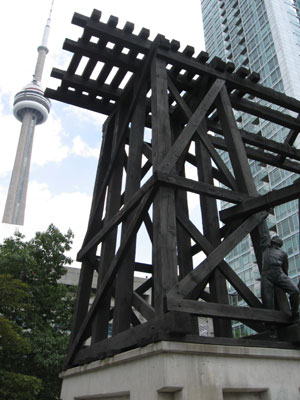
Chinese Railway Workers Memorial
Curving around the southern façade of the Rogers Centre
I arrived at Roundhouse Park, a large public space immediately to
the south of the CN Tower, named after the John Street Roundhouse,
a facility for the inspection, service and repair of locomotives,
built in 1929. The facility, today a designated National Historic
Site, was closed a long time ago, and today is home to Toronto’s
Steam Whistle Brewery Company which produces a popular premium pilsner
beer.
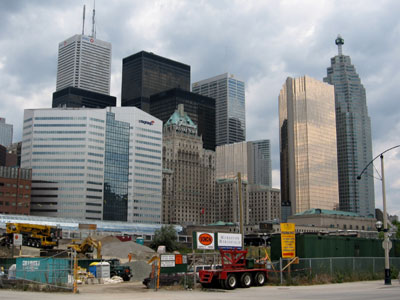
Downtown skyline viewed from Roundhouse Park
Continuing on I cycled underneath the Gardiner Expressway, an elevated
highway that connects downtown Toronto to its western suburbs, and
I finally arrived at Toronto’s waterfront in an area called
Harbourfront. Surrounded by a multitude of high-rise condominiums,
Harbourfront is one of Toronto’s premier entertainment districts
and features restaurants, a shopping centre for high-end retailers,
galleries and a theatre. An international market offers merchandise
and food from all over the world. A multitude of sightseeing boats
of all kinds docks at the foot of Harbourfront and free concerts
delight the plentiful crowd.
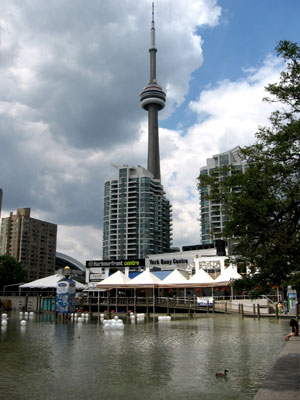
Harbourfront
From here I took the bicycle trail on Queens Quay to continue into
Toronto’s East end and to finally arrive at home after a solid
four or five hours of riding and discovering some of Toronto’s
exciting neighbourhoods.
Useful books about Toronto:
Related articles:
A cross-city bicycle
tour, Salsa on St. Clair and several free concerts
Exploring
the Toronto Islands by bicycle
A walking tour
through Toronto's vibrant Chinatown & Kensington areas
A St. Lawrence culinary
tour with Bruce Bell
Celebrating diversity
with a tour led by Bruce Bell
Toronto's historic
Distillery District with Matthew Rosenblatt
Presenting: Christina
Zeidler and the revitalized Gladstone Hotel
Casa Loma and
the fascinating personality of Sir Henry Pellatt
Exploring the
nooks and crannies of Casa Loma
The historic Royal
York Hotel - one of Toronto's crown jewels
Doors Open 2006, Toronto's
architecture festival
Presenting: the organizers
of Doors Open
|